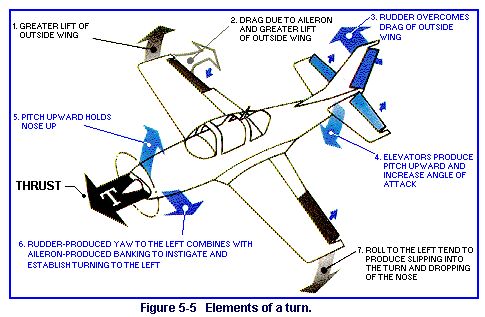 |
|||||
| Home | Research | For Teachers | HISTORY Level 1 Level 2 Level 3 |
PRINCIPLES Level 1 Level 2 Level 3 |
CAREER Level 1 Level 2 Level 3 |
| Gallery | Hot Links | What's New! | |||
| Web Administration and Tools | |||||
 |
|||||
| Home | Research | For Teachers | HISTORY Level 1 Level 2 Level 3 |
PRINCIPLES Level 1 Level 2 Level 3 |
CAREER Level 1 Level 2 Level 3 |
| Gallery | Hot Links | What's New! | |||
| Web Administration and Tools | |||||
![]()
Basic flight maneuvers include climbs, descents, turns, and combinations of these. generally, the basic flight maneuvers are started from what is called straight and level flight.
Straight and level flight (also called controlled flight) is a flight condition where the wings are kept level and the altitude and heading constant. Power setting is maintained at 55 percent to 75 percent of available power, using a higher setting within this range if speed is desired and a lower setting if fuel economy is desired. Straight and level flight is really a series of slight adjustments or corrections in pitch, yaw, and roll to keep the wings level and heading and altitude constant. A very good pilot can hold a constant heading and altitude so smoothly that a passenger can scarcely see the control movements.
Climbs are a combination of power and "up elevator." The amount of power used determines whether the climb is steep or shallow. If, for example, a pilot is taking off and must clear trees near the end of the runway, all available power must be used and the climb angle must be as steep as possible. This is called the best angle of climb, but it is a short-term climb. A sustained climb at this angle can overheat the engine because there is too little cooling air flowing around the engine's cylinders. The reason the airflow is reduced is the relatively low airspeed resulting from the steep climb angle.
Normal descents are a combination of reducing power and adjusting to maintain the desired airspeed. The airspeed is maintained by varying pressure on the control wheel. This, as you know, varies the angle of attack and, consequently, airspeed.

The third basic maneuver is the turn. Turns are either gentle, medium, or steep; and they may be made when climbing, descending, or while not gaining or losing altitude. Causing the airplane to turn requires smooth coordination of aileron, rudder, and elevator controls; in other words, pressure on the control wheel and the rudder pedal should be applied simultaneously. Why? The moment a wing begins to rise in a banked turn, it experiences more drag because of the lowered aileron and its higher angle of attack. A simultaneous application of rudder compensates for this additional drag by making the airplane also rotate about its vertical axis (see figure 5-5 ).
Once the coordinated turn is established, ailerons and rudder usually are neutralized. If the turn is of medium bank, the airplane will hold the amount of bank established, but it will not hold its altitude. It will begin a descending turn. The reason for the descent is that, in a bank, the direction of lift is not exactly opposite to the direction of gravity (weight); therefore, lift has to be increased. The pilot increases lift by holding back pressure on the control wheel which raises the elevator and increases the wing's angle of attack.
As you might expect, straight and level flight is achieved from the turn by coordinated use of the controls. Back pressure on the control wheel is relaxed while simultaneously applying opposite-to-turn aileron and rudder pressures.
Send all comments to ![]() aeromaster@eng.fiu.edu
aeromaster@eng.fiu.edu
© 1995-98 ALLSTAR Network. All rights reserved worldwide.
| Funded in part by | From Civil Air Patrol Educational Materials |
Updated: February 23, 1999